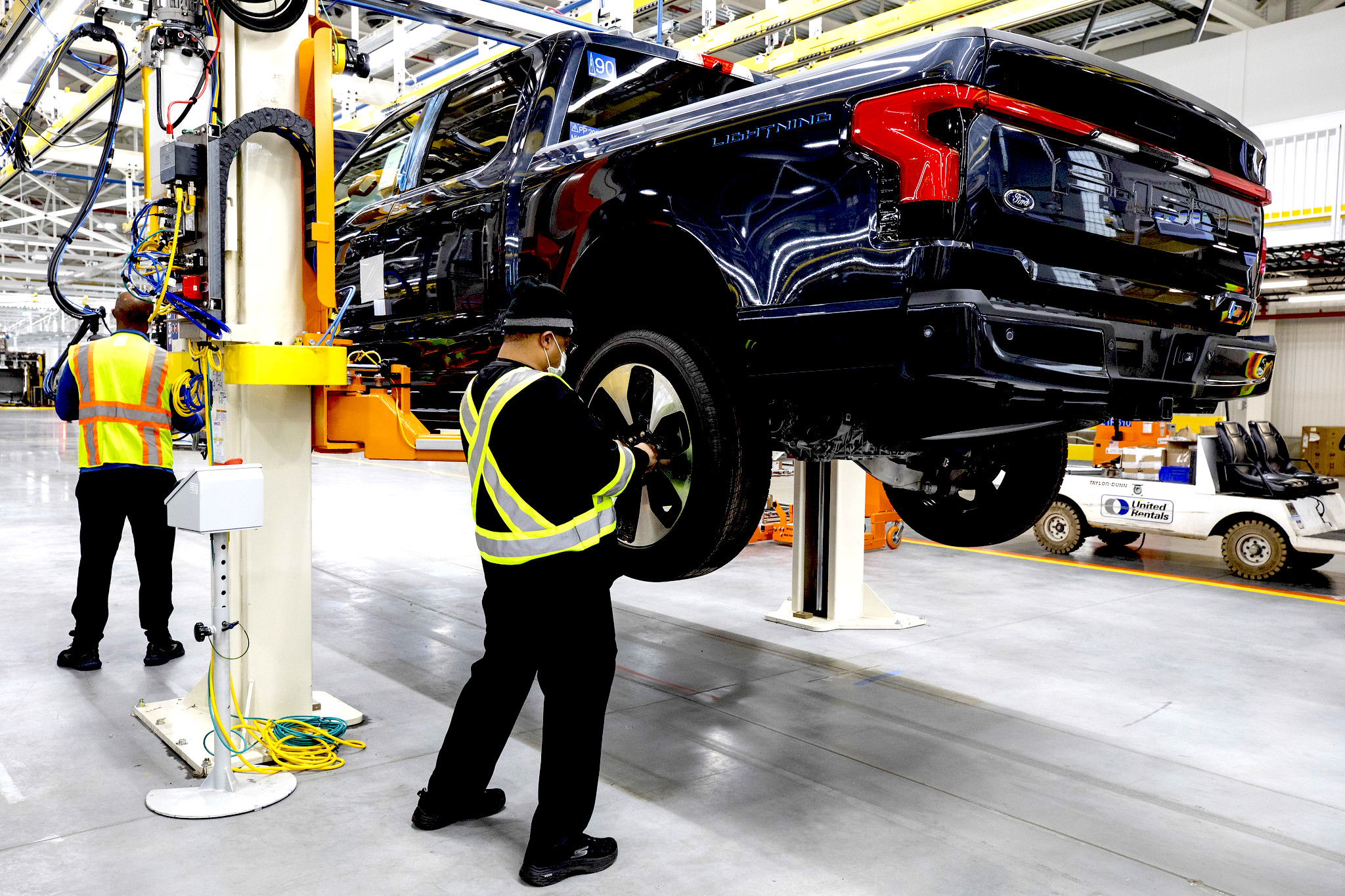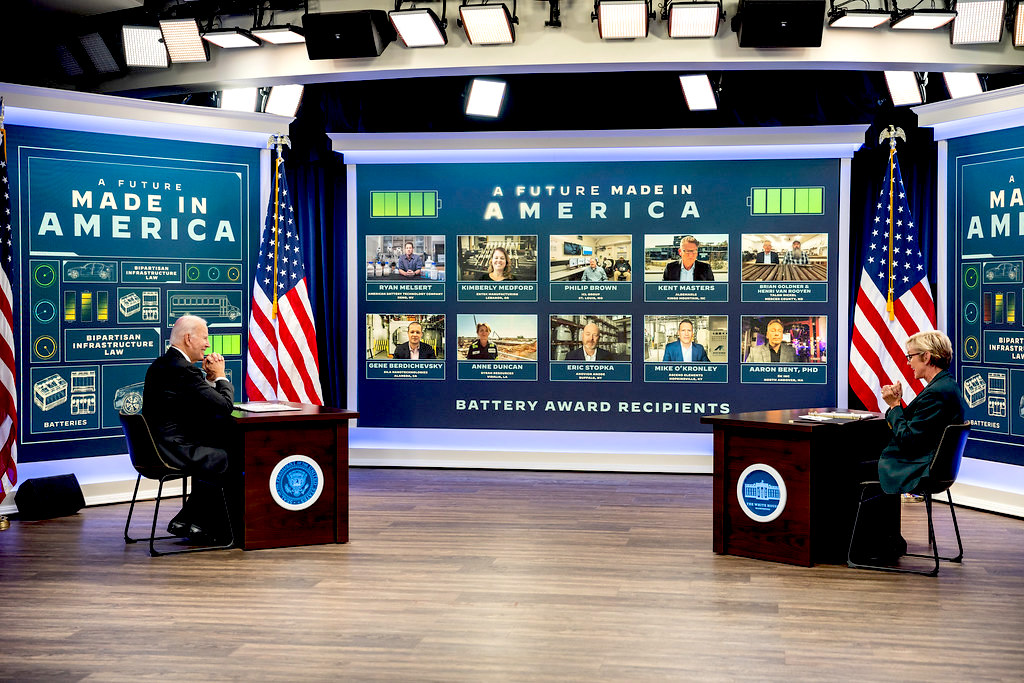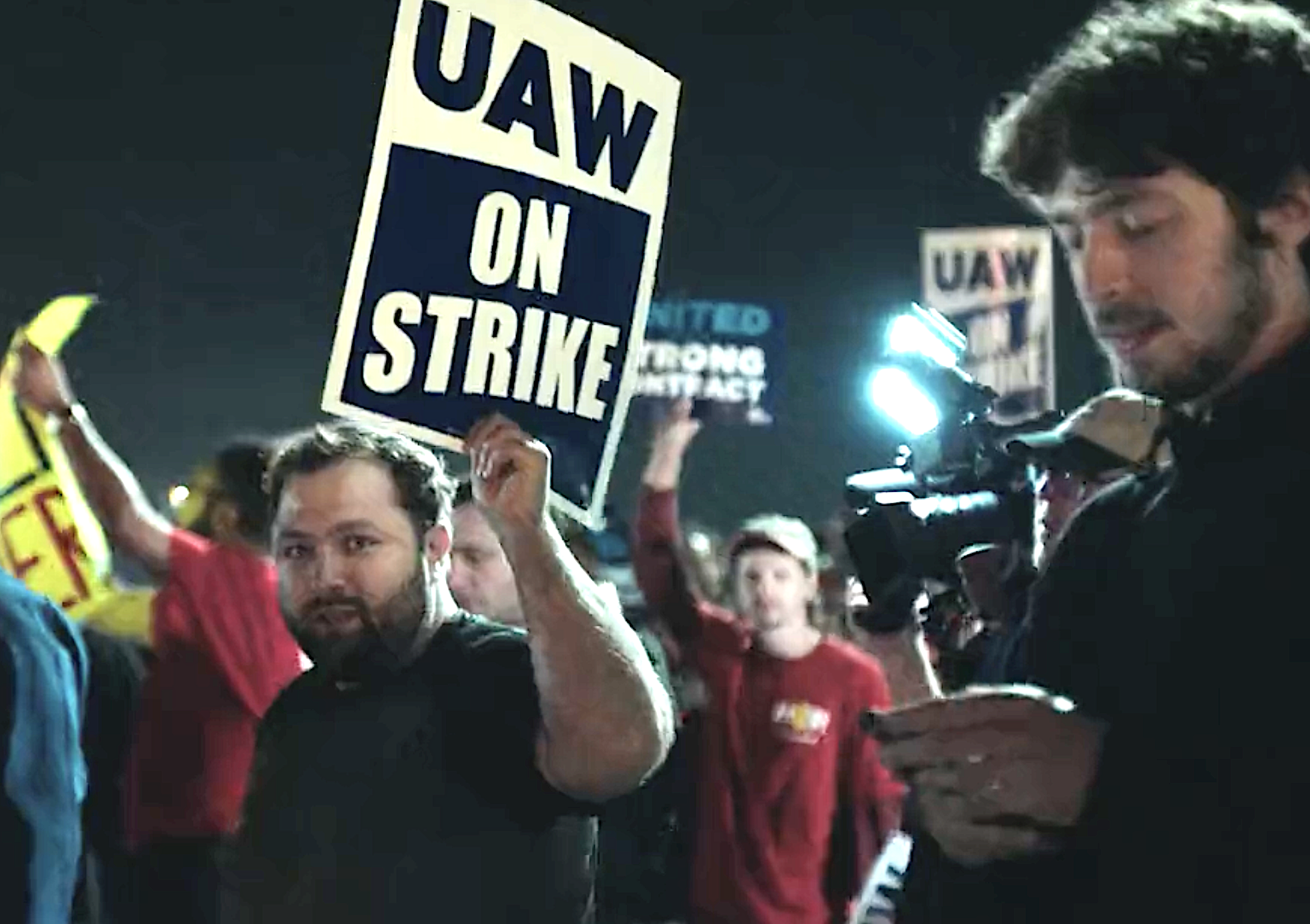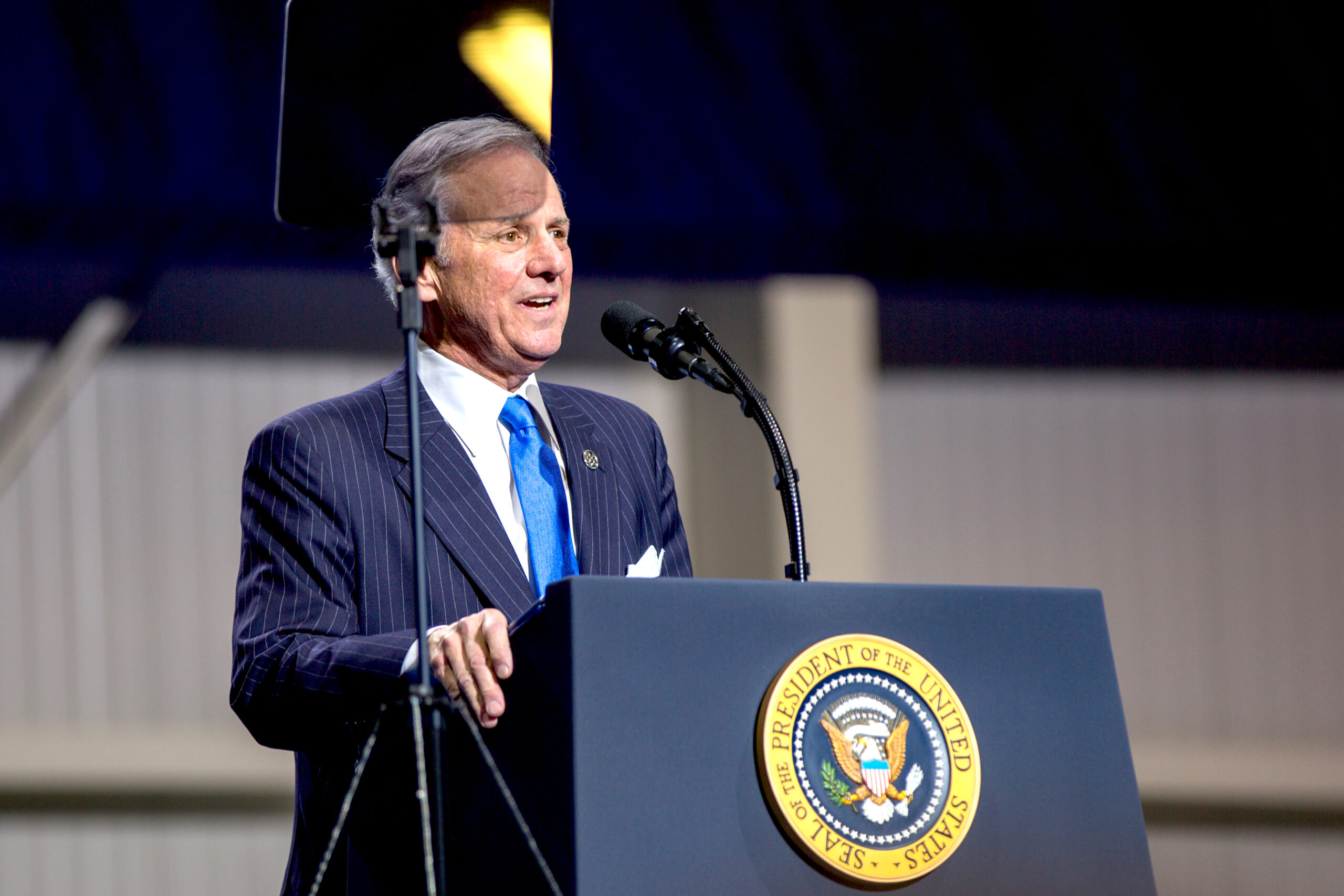Ben Carroll reports on an EV manufacturing boom that is bringing heavy investment into the South and, in the process, creating a new battleground for union organizing.

Assembling the all-electric F-150 Lightning pickup at the Rouge Electric Vehicle Center in Dearborn, Michigan, December 2021. (Automotive Rhythms, Flickr, CC BY-NC-ND 2.0)
By Ben Carroll
Labor Notes
Towering cranes pierce the sky, contrasting with the rural surroundings. It’s an early morning in June, the air already gauzy and thick, and construction is humming at the Toyota Battery mega-site in Liberty, North Carolina.
Trucks and other heavy machines dart in and out of the complex. A line of food trucks is tucked around the corner, alongside a dozen tour buses used to move workers.
Production is slated to begin in 2025. By 2030, when the 7 million-square-foot complex is fully operational, it will have 14 production lines — 10 dedicated to batteries for electric vehicles and plug-in hybrid electrics, and four for hybrid electric vehicles — operated by 5,100 workers. The total population of Liberty is 2,655.
Though this factory stands out for its staggering $13.9 billion price tag, it’s one of several electric vehicle (EV) plants under construction or soon to break ground across the South.
Manufacturing Boom
Dubbing the region the “Battery Belt,” federal and state governments are ushering in a dizzying manufacturing boom in nearly every aspect of the EV supply and production chain — from charging stations to mineral refining, battery production to battery storage and disposal.
In Kings Mountain, North Carolina, a pair of companies backed by a $90 million grant from the Department of Defense have plans to drain a lake that was once an open-pit lithium mine, and resume mining. The companies expect it will yield enough lithium for 1.2 million electric vehicles per year; this lithium will be refined at a soon-to-open $1.3 billion facility in nearby Chester County, South Carolina.
Much of the dramatic expansion in investment is a result of the Inflation Reduction Act (IRA) passed in 2022. The bill included tremendous financial incentives, largely in the form of grants and tax credits, to encourage production for cleaner energy.

U.S. President Joe Biden and Energy Secretary at the electric vehicle battery awards on Oct. 19, 2022, at the White House. (White House/Adam Schultz)
On top of this federal money, state governments are heaping record-breaking incentive deals on EV manufacturers in the form of tax breaks, infrastructure development, and funding for workforce development.
Georgia, for instance, will give Hyundai up to $2.1 billion in tax breaks and other state assistance for its $7.9 billion capital investment in an EV and battery production complex outside Savannah, forecast to employ up to 8,500 workers.
Alongside its stated goals to reduce greenhouse gas emissions and slow climate change, the IRA is part of the U.S. effort to compete with China, which currently produces the most EVs at the lowest prices.
“We want to contain China, even if it comes at the expense of addressing the world’s climate change crisis,” Stephen Roach, the former chair of Morgan Stanley Asia, told Axios in July.
The Biden administration recently imposed massive tariffs on imports from China related to various aspects of EV production. These policies are meant to create an entirely domestic supply and production chain for the development of electric vehicles — a process that’s well on its way to being realized.
Factories Flee to the South
Since the passage of the IRA, companies have announced $110 billion in capital investments in new EV manufacturing. Roughly half that money and the corresponding jobs, according to the EV Jobs Hub, are destined for the U.S. South.
Eighty-five percent of the investments are concentrated in right-to-work states [where unions cannot require membership as a condition of being hired]. S&P Global Market Intelligence estimates that as many as two-thirds of EV jobs may eventually be located in the South.
While Michigan tops the list in EV capital investments, Georgia, North Carolina and Tennessee are close behind, racking up investments of $23 billion, $20 billion and $17 billion respectively.
In Tennessee, a joint venture between Ford and SK On [a battery maker] is investing $5.6 billion to develop what it calls BlueOval City outside of Memphis — a six-square-mile complex where 6,000 workers will produce EVs and batteries. The company boasts it will be “among the largest auto manufacturing facilities in U.S. history.”
The site will also receive batteries from a BlueOval SK Battery Park in Kentucky, a $5.8 billion project that will employ another 5,000 people.
Workers are installing equipment at BlueOval SK Battery Park in Glendale, Kentucky. Production is on schedule to begin at Kentucky 1 in 2025! #BlueOvalSK #BlueOvalSK_KY pic.twitter.com/ef0qZDBkxM
— BlueOval SK (@BlueOval_SK) August 7, 2024
Outside of Columbia, South Carolina, Scout Motors (owned and operated by Volkswagen) recently broke ground on a site it has invested $2 billion into; once operational in 2026, it will employ 4,000 and produce 200,000 vehicles a year.
South Carolina is the country’s No. 1 exporter of tires, and already home to BMW’s massive 11,000-worker plant in Spartanburg. The BMW plant will soon begin receiving batteries from a nearby facility operated by AESC which in April announced an expansion of its initial plans, adding a second battery production facility, for a total investment of $3.1 billion.
More US battery manufacturing investment announced: AESC, which supplies batteries for BMW's North American operations, plans a $1.5 billion expansion of its South Carolina battery plant, bringing total investment in the site to $3.12 billion & 2,700 jobs.https://t.co/5vo30pxfVL pic.twitter.com/rL0BTACvNf
— Jesse D. Jenkins (@JesseJenkins) March 28, 2024
The labor and climate movements thus face a dual challenge: fighting for a just transition for workers into the new EV sector, and resisting the pitting of U.S. workers against workers abroad.
This breathtaking EV development is an acceleration of longstanding trends. Auto and other industries have been steadily increasing their footprint in Southern states for several decades.
They’re drawn to a reactionary, pro-business climate with the lowest union density, lowest wages and the most stringent anti-labor laws in the country. With strikes and organizing on the rise nationally, local politicians are underlining this selling point more than ever.
“The fact that you have these massive labor stoppages in the traditional union states definitely will benefit Southern states as companies are looking to grow,” Georgia Economic Development Commissioner Pat Wilson told the Financial Times last October, when the UAW’s Big 3 strike was in full swing.

Labor demonstration at a Ford plant in Wayne, Michingan, September 2023. (UAW, Twitter)
In March, Georgia passed a law forbidding companies that receive state incentives from recognizing a union by any method other than secret ballot elections.
South Carolina Gov. Henry McMaster, a descendant of slave owners, pledged in his State of the State address this year to “fight [unions] to the gates of hell.”
In a joint statement meant to scare Chattanooga Volkswagen workers out of organizing, he and five other Southern governors contended that the UAW drive “threatens the values we live by” and would “certainly put our states’ jobs in jeopardy.”
Nearly every new foreign-owned auto plant that has opened in the U.S. since the 1990s has chosen the South for its base of operations. And while the Midwest once was home to around 60 percent of all automotive jobs, that has since fallen to around 45 percent, while the South’s share grew from 15 percent in 1990 to 30 percent today.

McMaster in February 2017. (Wikimedia Commons, CC BY-SA 2.0)
The South is also the region that 60 percent of Black workers call home, along with a growing population of immigrant workers.
Beyond EVs, manufacturing in general is relocating South at a furious pace, with nearly two-thirds of plant construction investments in Southern states.
Now the UAW has channeled the momentum of its Big 3 strike victory into an ambitious, long-overdue campaign to organize the 13 non-union automakers, largely concentrated in the South — committing $40 million over the next two years to the task.
Workers at Ultium Cells in Lordstown, Ohio — which manufacturers batteries for General Motors — recently won a strong agreement that provides the UAW’s initial step into the EV industry.
Despite the governors’ threats, Chattanooga Volkswagen workers won their union vote overwhelmingly in April. Several weeks later, Daimler Truck North America workers in North Carolina, Georgia, and Tennessee won a record contract.
Fritz: Thank you folks. I am coming from Germany and I bring you the warmest greetings of the Volkswagen workers of Germany…They want to strengthen you and wish you the best success for the brothers and sisters of Volkswagen in Chattanooga. pic.twitter.com/0T1EDb4mmC
— Labor Notes (@labornotes) April 20, 2024
Workers at Mercedes in Alabama came up short in their May vote on unionizing. But the union’s continued organizing to build worker committees and shop floor militancy is contributing to an atmosphere that will encourage others to step forward and fight.
Last year, workers in Georgia at the country’s second-largest bus manufacturer, Blue Bird — which includes electric buses among the vehicles it produces — won a hard-fought victory to join the Steel Workers (USW).
Workers at another manufacturer of electrified buses, New Flyer in Alabama, voted yes this year for the Industrial Division of the Communications Workers (IUE-CWA), joining unionized plants in Kentucky, New York, and Minnesota.
Find the Chokepoints
The rise of the EV industry, and big manufacturing operations generally, presents many organizing challenges — for one, these plants are huge. The 2024 elections and looming anti-union Supreme Court decisions may also add new challenges to organizing everywhere.
However, some characteristics of this burgeoning industry — especially its localized supply chains and sometimes even vertically integrated operations, where the battery, the parts, and the whole car are made at one site — may open opportunities.
If workers can identify key chokepoints in the production process — where a small group of workers taking action has outsized power to disrupt operations — they can use that leverage to win workplace demands and eventually union recognition.
Workers may look first to develop industrial networks where they can exchange lessons, build committees with others around them, and closely analyze how these facilities work to identify critical junctures for action — much like the auto workers who led the Flint Sit-Down Strike in 1936-37 that led to the growth of the UAW.
The Southern Workers Assembly, a cross-sector rank-and-file network, has recently launched a program aimed at getting workers jobs in strategic sectors to organize.
Other major unions should follow the lead of the UAW and invest serious resources to take advantage of the opportunities of this period and lay the foundation to organize in EV and other growing sectors across the South.
Ben Carroll lives in Durham, North Carolina and is the organizing coordinator for the Southern Workers Assembly.
This article is from Labor Notes.
The views expressed are solely those of the authors and may or may not reflect those of Consortium News.

I would like to also add that the worker’s union and many others have same concerns. Remember Fred Hampton, a 21 year old who brought both white and black people together on shared issues. Remember it seemed very dangerous for the white supremists at that time. It will be very dangerous for capitalism when a leader comes that says it like it is. Those in power love capitalism for a reason and will protect it at any cost; Palestinian lives, American lives, Ukrainian lives, it matters not to them cause they have not children, relatives, or any other kind of skin in the game they are playing. You do.
I would like to know, and it could only be told by time, about how these workers fare in the future. I think most western countries are attempting to quell union voices. So how does this cue with what’s happening in the rest of the Western world? A narrow vision is a limited one. Look elsewhere, look all around. then you might know something ahead of even your legislators, a bunch of swift talking dummies.